In the ever-evolving world of vaping, we’re always on the lookout for the next big thing. Lately, the buzz has been all about Quartz heating elements commonly referenced as atomizers and coils. After several rounds of emission testing we’ve got some exciting insights to share with you. We’ve teamed up with ADACT Medical Ltd, the cool cats with the ISO17025 Certified Lab credentials specializing in Vapour Analysis, to unravel the mysteries of these heating elements. So, grab your vape, and let’s dive into the details!
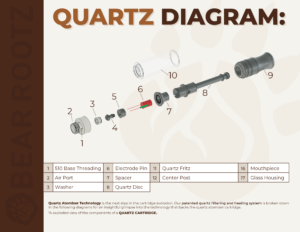
Figure 1a. – Quartz Cartridge Diagram
Topics
Goals Of Research
The goals of the research are twofold.
- Demonstrate the superiority of quartz coils over ceramic coils in terms of flavor and consistency.
- Demonstrate the superiority of quartz coils over ceramic coils in terms of silicate shedding.
Methodology
This was the experimental design that was undertaken.
- For degradant products in vapor analysis, we will put both tank types on a test rig with a ‘standard liquid’ and vape it for a full lifecycle, samples for analysis will be collected at the start, middle, and end of the vaping cycle, 10 puffs will be used at each test cycle using ISO puffing topography. This will enable us to compare the two devices for 27 degradant components, the hypothesis is that the better flavor comes from lower levels of burning and hence lower degradation products.
- Silicate particles in the vapor analysis can also be undertaken, for this we will vape a device for a full life cycle and pass the vapor through an impinger which should capture the silicates in a solution. We can then use a HIAC Liquid Particle Counter to assess the particle size and distribution to make a comparison between the devices. (updated methodology, we ran the vapor through two impingers in series to get better silicate retention from the test)
- The FDA-Compliant testing protocol was implemented for the testing, this is 27 HPHCs done in triplicate
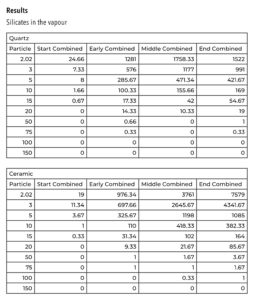
Figure 2a. – Results
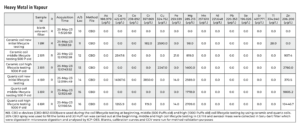
Figure 3a. – Results

Figure 4a. – Results
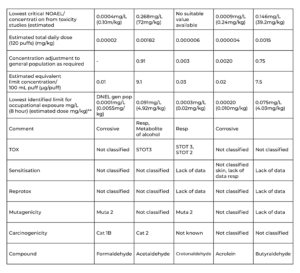
Figure 5a. – Results
Discussion of Results
Silicates in the vapor: The total particle count for silicates was significantly lower for the quartz devices than the ceramic coils total particle counts of 3178 vs 13, 644. The overall distribution was quite similar.
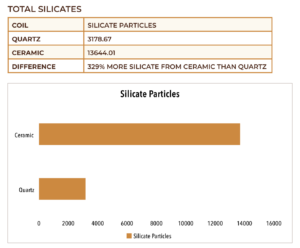
Figure 6a. – Total Silicates Results
Aldehydes in Vapor
This is another area where the quartz coils outperformed the ceramic coils, except for formaldehyde, the degradant products produced by the ceramic were significantly higher for Acrolein, crotanaldehyde, and butyraldehyde, both types were similar for Acetaldehyde. This demonstrated a much higher level of ‘burning’* or overheating with the ceramic coils and may explain the better taste profile reported by consumers with a quartz coil.
The levels of degradants were not a safety issue, as they are within the bounds of what we expect (and within a 400-fold margin of safety), but only demonstrated that the quartz product caused less overheating, or ‘burning’, than the ceramic coil. All the degradant products researched here are irritants, formaldehyde is considered less irritant than the other products discussed. (see table below) please note that mg/lt can be read as ppm, (there is a slight difference) the levels are higher than the NOAEL but not at levels that will cause issues.
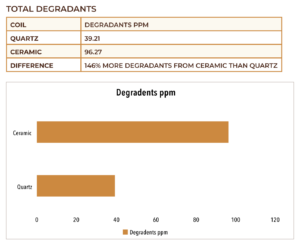
Figure 1b. – Total Degradants Results
Conclusion
In conclusion, our Bear Rootz Quartz vs. Ceramic Coil Testing Showdown, conducted in collaboration with ADACT Medical Ltd, has provided valuable insights into the performance of these popular vaping coils. The comprehensive analysis focused on degradant products and silicate particles in the vapor, aiming to address the ongoing debate surrounding Quartz and Ceramic coils.
Executive Summary
The results indicate that Quartz coils outperform Ceramic coils in terms of both flavor and safety. The levels of silicates in the vapor were significantly lower for Quartz devices compared to Ceramic coils, demonstrating a reduced risk of inhaling potentially harmful particles. Furthermore, the analysis of degradant products revealed that Quartz coils exhibited lower levels of these compounds, indicating less overheating and burning during the vaping process.
While some degradant products were present in both coil types, they remained within safe limits, emphasizing the overall safety of vaping using these coils. The slight elevation in formaldehyde levels from Ceramic coils did not pose a safety concern, as it fell within an acceptable range with a substantial margin of safety.
Our research aligns with the goals set at the outset, confirming the superiority of Quartz coils over Ceramic coils in terms of flavor, consistency, and safety. The hypothesis that Quartz coils provide a better vaping experience due to even heating and reduced burning is supported by scientific data. Additionally, the lower levels of silicate shedding contribute to the improved safety profile of Quartz coils.
In the realm of vaping, where technological advancements continue to shape the landscape, our study contributes to the growing body of knowledge surrounding coil performance. As consumers seek not only enjoyable vaping experiences but also safer alternatives, the findings of this research provide valuable guidance. The data presented here can aid both manufacturers and users in making informed decisions about the choice of coils, ultimately enhancing the overall vaping experience.


Its like you read my mind! You seem to know a lot about this, like you wrote the book in it or something. I think that you can do with a few pics to drive the message home a little bit, but other than that, this is wonderful blog. A fantastic read. I’ll definitely be back.
Results really help make an informed choice for my vaping setup. Thanks for sharing the comparison!